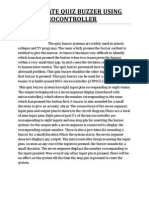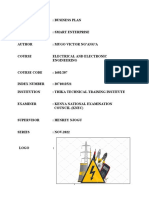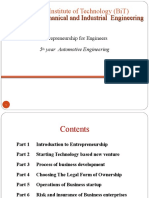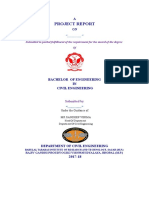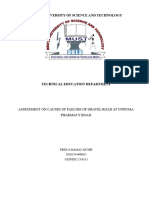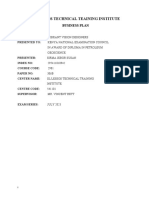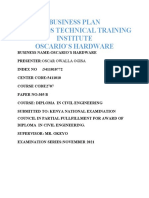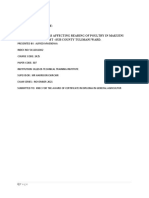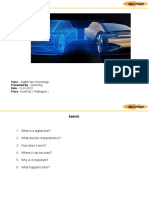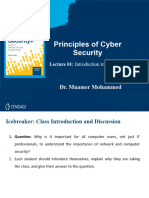OL’LESSOS TECHNICAL TRAINING INSTITUTE
TRADE PROJECT
NIGHT SECURITY LIGHT
PRESENTED BY : CAFIN KIPLIMO
INDEX NO : 5411010195
CENTER NO : 541101
COURSE CODE : 2601
PAPER NO : 306A
PRESENTED TO THE KENYA NATIONAL EXAMINATION COUNCIL
IN PARTIAL FULFILLMENT FOR THE AWARD OF DIPLOMA IN
ELECTRICAL ENGINEERING (POWER OPTION).
SUPERVISOR : MR. MICHAEL SAWE
EXAM SERIES : NOVEMBER 2021
i
�Declaration
I declare that this is my original work and has not been submitted to the Kenya
National Examination council by anybody else in any institution for the award of
Diploma in Electrical engineering .
Name : Cafin Kiplimo
Sign:………………………
Date:………………………
Approval of Ol’lessos technical training institute supervisor
Name :Mr. Michael Sawe
Sign:………………………….
Date:………………………….
ii
�Dedication
I dedicate this project to my loving parents for their tireless effort and the
contribution towards my academic professional excellence.
iii
�Acknowledgment
My sincere gratitude goes to my Heavenly Father who has ranted me grace and
knowledge, Care and support up to this particular time.
My sincere acknowledgment goes to my supervisor Mr. Sawe for their technical
piece of advice and moral support, their tireless effort guidance and making books
available for references thus making this work a success
May the Almighty God Bless you all. Thank you.
iv
�Abstract
The Night light is a simple engineering project which can be installed in the streets
of towns and market places and also used in residential places for security
purposes.
The project itself involve automatic lights that switch ON during the night
automatically and goes OFF during the day thus it requires very few components to
be installed these include LDR,Timer,Diodes,and relay.
The advantage of the project design is that it is cheap in both cost and
construction.Again it is automatic ie.operates ON at night and OFF during the day
without the need of operations.
v
�Rationale
The importance of this project is an automatic simply because.
a. It lights during the night and goes OFF during the day.
b. It lights automatically without the need of operation.
c. It requires less maintenance cost
d. Used in fault finding and testing also helps technicians to perform the duties
of design and methodology.
vi
�Table of Contents
Declaration..................................................................................................................................................ii
Dedication...................................................................................................................................................iii
Acknowledgment........................................................................................................................................iv
Abstract.......................................................................................................................................................v
Rationale.....................................................................................................................................................vi
Chapter One................................................................................................................................................1
1.0 Introduction...........................................................................................................................................1
1.2 Objectives of the Project.......................................................................................................................1
1.3 Statement of the problem.................................................................................................................1
Chapter Two................................................................................................................................................2
2.0 Literature Review............................................................................................................................2
2.1 Stable multi vibrator..........................................................................................................................2
Operation of a Stable Multi Vibrator...........................................................................................................3
2.1 Resistors.........................................................................................................................................3
2.1.1Factors to Consider when choosing a resistor.....................................................................................4
Transistor.....................................................................................................................................................5
Transistor Circuits........................................................................................................................................6
Common Base Connection..........................................................................................................................6
2.3 Diodes..............................................................................................................................................7
2.3.1 Types Of Diodes..........................................................................................................................8
2.3.2 Main Function of Diode..............................................................................................................9
2.4 Transformers..............................................................................................................................10
2.5 Capacitors............................................................................................................................................11
2.5.1 Types of Capacitor............................................................................................................................12
2.5.2 Uses of Capacitors.....................................................................................................................13
Chapter Three............................................................................................................................................14
3.0 Block Diagram of Modern Automatic Night Light.........................................................................14
vii
�3.1 Circuit Diagram....................................................................................................................................15
3.2 Operation Of The System..............................................................................................................16
3.3 Importance of the Project....................................................................................................................16
Chapter Four..............................................................................................................................................17
4.0 Fabrication.....................................................................................................................................17
4.1 Components Used...............................................................................................................................17
4.2 Testing and Results..............................................................................................................................18
4.3 Led Testing.....................................................................................................................................18
Chapter Five..............................................................................................................................................19
5.0 Conclusion...........................................................................................................................................19
5.1 Recommendations.........................................................................................................................19
5.2 Challenges Faced During the Designing of the Project........................................................................19
Reference..................................................................................................................................................20
viii
�Chapter One
1.0 Introduction
Nowadays use of an automatic night light produce light in the streets and market places have a
large application in most of the countries of the world.
Big towns and marketing places used this device to minimize the theft in towns and improve
sales of product during night times. This intends to be starting point to change this reality
involving the academic researchers in the study of this problem.
1.2 Objectives of the Project
i. A working project
ii. To test the project
iii. To minimize the cases of insecurity in towns.
iv. To advance economy in towns.
The device id enough to light during the night in the places at different positions.
Simple to make and to implement in the streets of the towns and market places.
To reduce theft because in the project produces sufficient light during night hence minimize
theft.
1.3 Statement of the problem
The purpose of the project is to reduce theft in towns and enable business men to run their
business at night times. Implementing this kind of project can help to reduce theft in towns up to
30%.
9
�Chapter Two
2.0 Literature Review
2.1 Stable multi vibrator
Where
C- Capacitors
R – Resistors
Q- Transistors
A stable vibrator using 555 timer I.C is done by using resistor and capacitors and it’s operational
amplifiers. The 555 timer is from minutes to hours. The oscillator frequaency can be measured
manually by small modification circuit can be controlled by shifting the voltage values of resistor
R1,R2 and C1
R1
VCC A
OUTPUT
+
R2
10 R3
�Operation of a Stable Multi Vibrator
The circuit has two a stable (unstable) state that change alternatively with maximum transition
rate because of the accelerating positive feedback. It is implemented by compiling capacitor that
instantly transfer voltage charge because the voltage across the capacitor cannot suddenly
change. In each state transistor is switched and the other is switched OFF. According to one fully
charged capacitor is charged (reverse charge ) slow thus converting into exponent charging
voltage. At the same time the exponent charging voltage. At the same time the other empty
capacitor quickly changes thus restoring it’s charge (the first capacitor) it acts as the time
setting capacitor and the second repairs to play this role in the next state hence the circuit
operates based on the forward biased base emitter functions of switched on bipolar transistor can
provide path for capacitor restoration.
2.1 Resistors
A resistor is a passive component with two terminal electrical component that it implements
electrical resistance as circuit elements. A resistor may be used to reduce the current flow and at
the same time may act to lower the voltage level within the circuit to limit the current flow and
also adjust the signal level biase the active element and the transmission line among the other
uses.
Electronic Symbols
Or IEE SYMBOL
ELEMENTS SYMBOLS AND RESISTORS
Reostar (variable resistor)
Resistor
11
�2.1.1Factors to Consider when choosing a resistor
(a) Tolerance value
It cannot be guaranteed by mass production method but this is not greater disadvantage because
most electric circuit the value of resistors are not critical. The tolerance determines the minimum
or maximum value of resistors might have.
(b) Power rating
If the ratio at which the resistor charges electric energy into what exceed it’s power rating it
will over heat and it can be damaged or destroyed.
(c) Stability
This is the ability of the components to keep the same value of it’s age despite of changes to the
temperature return and the other physical conduction.
(d) Fixed resistors
i. Carbon composition
This are of mixture of carbon which is pressed and involved into rods by heaty value
rapidly from few ohm to 10m a typical tolerance is10% and the rating are from 0.12s w to 1w.
Their ability is poor they are cheap but noisy they introduce unwanted voltage due to a s
saturated composition but tolerance is better and stability is very good.
ii. Metal oxide
This is a high ability and high period of time tolerance voltage electrons easy rushing some in
loud speaker and audio equipment .
Carbon film / metal film resistors
A carbon or film is depolarized as ceramic rod and protected by tough insulation costly value
rational cost similar to carbon.
Is 3% at ration show their contribution and appearance is similar to the carbon film type.
12
�Transistor
It can be classifieds unipolar and bipolar based on the charge carries taking part in conduction charge
carries. A BJT is the three terminal two junction semi conductor device and the conduction here is due to
charge carries.
Advantages of BJT
1. Low current is required
2. Low operating voltage
3. Small in size
4. Less weight
Types of transistors
N.P.N transistor
P.N.P transistor
P N P N P N
A transistor (PNP) or (NPN) has three sections
- Emitter
- Base
- Collector
-
a) Collector
It has a terminal which collects charge and its large of the thre required and dissipate more heat
it’s base is moderate by doping it has always reversed biased.
b) Emitter
It is the section that supply charge carries a hole having doped. It’s always forward biased with
respect to the base so that it can supply large number of majority carries.
c) Base
13
�This is the middle section with few P.N function between the emitter and the collector. The base
emitter functions is forward biased allowing the low resistance for the emitter.
The base collector functions is reverse biased and provides resistor in the collection circuit. The
base is highly doped and very thin and it is less than 1mm wide function is controlled. The flow
of current across both junctions.
N P N
Drain
G1
Source
G2
- +
J FET
Transistor Circuits
Common Base Connection
E C
Input B output
14
�Common emitter connection
E
B
output
Input C
Common emitter configuration
E
B
output
C
2.3 Diodes
A diode is a two terminal component that conducts primarily in one direction (asymetric). Itn
has a low resistance the flow of current is in one direction.
Semiconductor diode id the most common type of cyrystalline diode of semiconductor mmaterial
with PN junctions connected to two electrical terminals. A vocuumtube diode has ntwo
electrodes; a plate (anode) and a heated cathode. Semi conductor diode where the first semi
conductor electric devices.
anode cathode
15
�2.3.1 Types Of Diodes
(a) Zenor diode
Used in stabile nary the voltage of a power supply mist normally used in the reverse biased state.
(b) Light emitting diode
Emits light when forward blasé used to display flow of current
(c) Photo diode
Consist of a normal PN junction in case with a transparent window through when light can
enter.
symbol.
d) Schoky diode
16
�2.3.2 Main Function of Diode
The most common function of diode is to allow an electric current to pass in one direction
(forward direction) but the blocking current in the opposite direction (reverse direction)
The unidirectional behavior is called rectification and it is used to convert A.C to D.C
including extraction of modulation from the radio signal in radio receiver but those diode in
form of rectifiers.
Diode I – V characteristics
The following show the relationship between forward current and forward voltage.
IF Forward biased region
REVERSE BIASE
Breakdown
IS
2.4 Transformers
Basic transformer
17
�Transformer is an electrical device that transfers alternating current energy from one circuit to another
circuit by magnetic coupling of primary and secondary windings of transformer. This is accomplished
through mutual inductance (M). the voltage applied to the primary winding causes current to in the
primary.
This current generates a magnetic magnetic field, generating a counter EMF which has the opposite
phase to that of the applied voltage. The magnetic field generated by the current in the primary also cuts
the secondary winding and induces a voltage in this winding.
2.5 Capacitors
18
� Capacitor is device which store energy in form of electric energy the property of a capacitor to
store an electric charge when its plates are at different potential is known as capacitor
Capacitance is the charge required per unit potential difference by definition the unit of
capacitance is conlomb/volts which is also farad (in honour of Michael farady)
I farad = 1 conlomb/volt
One farad is defined as the capacitance which required charge of one conlomb to establish a bid
of one volt between the plates one farad is actually two large for practical purpose.
symbols
+ - fixed non –polarized
fixed polarized
The capacitation of a capacitor depend on
1] Cross sectional area of the plate
2] Separating distance of the plate.
The dielectric used
Factors considered when selecting capacitor.
1] The value
2] The tolerance
3] The stability
4] Work voltage
19
�5] Leakage current.
2.5.1 Types of Capacitor
FIXED CAPACITOR
1] Paper capacitor
Mostly used in the power circuit of the house hold appliance.
2] Electrolytic capacitors
Consist of two aluminum foils are with fixed oxide film and one without.
3] Mica capacitor
Mainly use in high frequency circuits.
4] Polyester capacitor
Relatively small in size and can operate in high voltage.
5] Ceramic capacitor
They are much smaller than corresponding aluminum electrolyte capacitor layers of manganete
dioxide and graphite from electrolyte.
[b] VARIABLE CAPACTORS
These require two sets of rigid plates which can be moved between one another, normally used
to tune radios.
20
�2.5.2 Uses of Capacitors
1] Used in power supply to smoothen the output of a fall or half way rectifier.
2] Used in charge pump circuit as the energy storage element in generation of higher voltage
than the input.
3] Can be used to separate than+e and D.C components of a signal
4] Used as motor starts.
5] Store energy
6] Suppression and coupling
7] Supply pulsed power.
21
�Chapter Three
3.0 Block Diagram of Automatic Night Light
DC POWER
SUPPLY
TIMER RELAY SWITCH
LDR
POTENTIOMENTER LIGHT
3.1 DC POWER SUPPLY CIRCUIT
22
�3.2 CIRCUIT DIAGRAM
+ Lamp
12VDC
23
NC
10k 4 8
�3.2 Operation of the System
1
When the light dependent resistor (LDR) receive light the voltage at pin 2 (trigger pin) is above of
3
VCC.
The output pin 3 goes low (o) and the relay is not activated to put on light because it is daytime.
1
When darkness come LDR will NOT receive any light and the voltage at PIN 2 is below of VCC, the
3
output pin 3 goes high (1) and the relay is activated to put on Lights because it is nighttime any small
change in pin 2 will cause a corresponding change in pin 3 from either Low to High or High to Low.
3.3 Importance of the Project
Uses the energy from the diode in order to work
Requires little maintenance
Simple to design
Cheap in terms of cost and installation.
24
�Chapter Four
4.0 Fabrication
4.1 Components Used
NO MATERIALS EQUIPMENT TOOLS
1. Transformer Multimeter pliers
2. Diode Multimeter Soldering iron
3. LED Multimeter pliers
4 Wire Multimeter Pliers
5 Soldering wire Soldering iron
6 LDR Multimeter Pliers
7 Resistor Multimeter Pliers
25
� 8 Diode Multimeter Pliers
9 IC Oscillator
1 Capacitor Multimeter Long nose pliers
1 PCB Soldering iron
1 solder sucker
1 Relay Multimeter Soldering iron
13Switch Multimeter pliers
4.2 Testing and Results
It is always wise to carry out circuit test before commissioning it the light detector was
subjected to various test to establish whether there is
26
�1] Continuity test
2] Short circuit test
3] Open test
Individual component test when also performed
Resistor testing
They are tested to verify if the resistor value up within the jump design specification
4.3 Led Testing.
This is tested to establish proper connection considerable value of resistance.
Cost analysis
27
�MATERIAL QUANTITY @ COST TOTAL COST
Transformer 1 800 800
Diode 4 50 200
Regulator 1 100 100
Resistor 1 30 30
Switch 1 100 100
LED 1 20 20
PCB 1 100 100
Plug 1 100 100
Flex 1 100 100
Solder wire 1M 100 100
Housing 1 300 300
Super glue 1 40 40
LDR 1 100 100
IC 1 200 200
RELAY 1 200 200
Connecting wires 1M 100 100
TOTAL 2460
28
�Chapter Five
5.0 Conclusion
The circuit did not work but not its due to errors and errors and approximation that
production of noise was vary upon high , after testing the flow of current was good due o the
testing by use of pulp in Led
Operation should be as per the specification of the project must be observed keenly.
5.1 Recommendations
1] The operation of this logic probe require a qualified person consistent with operation and
maintenance after breakdown
2] I recommend that since the project does not didn’t work properly let somebody who is
more advance assist me to complete project and ideas .
5.2 Challenges Faced During the Designing of the Project
-The cost of transportation during research time uses the major issue.
- Limited funds to do further research and lack of accessibility get in various companies around.
- It takes a quit a lot of time to design the project therefore wastes a lot of time.
29
�Reference
Electronic circuit [third edition] by Toley Mike
Electric principles and technology by Tama bhadhara.
Electric technology [by Theraja BL and Theraja AL].
Power electricity by ARODA
Semi conductor material by M.Sig.
30
